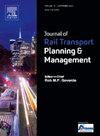Analysis of freight train passing a stop signal using machine learning: Application of XGBoost and SHAP
IF 2.7
Q3 TRANSPORTATION
Journal of Rail Transport Planning & Management
Pub Date : 2025-06-24
DOI:10.1016/j.jrtpm.2025.100532
引用次数: 0
Abstract
Passing a Stop Signal (PASS) is a critical safety concern in railway operations, with the potential to cause serious accidents. This study investigates non-human contributing factors to PASS events in Canadian mainline freight operations using machine learning. We analyze incident narratives from the Rail Occurrence Database System (RODS) through text mining and enrich them with geospatial and weather data. We develop a binary classification model using XGBoost and interpret feature importance and interactions with SHAP (SHapley Additive exPlanations). To address class imbalance and improve model performance, we apply a custom sampling method, combined with hyperparameter tuning and data standardization. Key contributors to PASS events include sharp track curvature near signals, downhill grades, low atmospheric pressure, high relative humidity, non-clear weather, and heavy traffic—placing Rocky Mountain subdivisions among the highest-risk areas. The model also reveals that combinations of environmental conditions, such as low temperature, low pressure, and high humidity, increase the likelihood of PASS events by reducing visibility and braking effectiveness. This study offers methodological and empirical contributions by modelling complex operational contexts, incorporating underexplored environmental factors, and producing region-specific insights. The proposed framework informs proactive safety strategies and supports risk analysis in other linear infrastructure systems.
货运列车通过停车信号的机器学习分析:XGBoost和SHAP的应用
通过停车信号(PASS)是铁路运营中一个关键的安全问题,有可能导致严重事故。本研究使用机器学习调查了加拿大干线货运业务中PASS事件的非人为影响因素。我们通过文本挖掘分析铁路事故数据库系统(RODS)中的事件叙述,并用地理空间和天气数据丰富它们。我们使用XGBoost开发了一个二元分类模型,并解释了特征重要性和与SHapley Additive explanation (SHapley Additive exPlanations)的相互作用。为了解决类失衡和提高模型性能,我们采用自定义采样方法,结合超参数调优和数据标准化。PASS事件的主要因素包括信号附近的急剧轨道曲率,下坡坡度,低气压,高相对湿度,不晴朗的天气和繁忙的交通,使落基山细分地区成为风险最高的地区。该模型还显示,低温、低压和高湿等环境条件的组合会降低能见度和制动效果,从而增加发生超车事件的可能性。本研究通过模拟复杂的操作背景、纳入未充分开发的环境因素和产生特定区域的见解,提供了方法和经验贡献。拟议的框架为主动安全策略提供信息,并支持其他线性基础设施系统的风险分析。
本文章由计算机程序翻译,如有差异,请以英文原文为准。
求助全文
约1分钟内获得全文
求助全文
来源期刊

Journal of Rail Transport Planning & Management
TRANSPORTATION-
CiteScore
7.10
自引率
8.10%
发文量
41
 求助内容:
求助内容: 应助结果提醒方式:
应助结果提醒方式:


